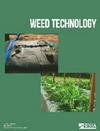甲硫唑啉草酯的用量和施用频率对控制草坪中的鹅掌柴和平滑蟹草有影响
IF 1.7
3区 农林科学
Q3 AGRONOMY
引用次数: 0
摘要
甲氧唑啉草酮(Methiozolin)被标明可用于控制高尔夫球场果岭上的鹅掌柴和平滑蟹草,但目前还没有关于该用途的同行评议文献。温室实验评估了鹅掌柴和平滑蟹草对甲噻唑啉草酮剂量增加的反应,这种反应受杂草生长阶段的影响。一般来说,随着杂草生长阶段的增加,减少 90% 杂草生物量(WR90)所需的甲唑啉比率也随之增加。鹅掌楸对芽前施用的甲唑啉比平滑草更敏感,鹅掌楸和平滑草的 WR90 分别为 30.4 和 118 g ai ha-1。然而,平滑蟹草对苗后施用的甲噻唑啉酮的敏感性普遍高于鹅掌柴。随后进行的田间研究评估了单独或按顺序在标准苗前施用甲氧唑啉酮对鹅掌柴和平滑草的控制效果。结果表明,按照标签建议的施用量(500 克/公顷-1)单次或连续施用甲氧唑啉酮,其持久性不足以对鹅掌柴和平滑蟹草进行全季控制。在阿拉巴马州、加利福尼亚州、佛罗里达州和弗吉尼亚州进行了十项实地研究,以评估频繁施用甲氧唑啉草酯的方案,目的是有选择性地对鹅掌柴和平滑蟹草进行长达一个季节的控制。研究结果表明,尽管某些处理方法超过了果岭草的年最大使用量(2500 克/公顷),但仍可在杂交百慕大草和匍匐翦股颖果岭草上安全施用甲噻唑啉酮。在加利福尼亚州和弗吉尼亚州,如果每两周施用 10 次甲氧唑啉草酮,用量在 250 克/公顷-1 或更高时,甲氧唑啉草酮可在整个生长季节有效控制平滑蟹草。在佛罗里达州,无论施用量多少,甲氧唑啉草酯都不能控制鹅掌柴(80%)。在弗吉尼亚州,只有当施用量和施用频率超过甲氧唑啉草酮的年最大使用量时,甲氧唑啉草酮才能控制鹅耳草。这些数据表明,如果经常施用甲氧唑啉草酯,它有可能控制平滑蟹草的出苗前生长,但按照标注的施用量,它不能提供可接受的鹅掌揪草控制效果。本文章由计算机程序翻译,如有差异,请以英文原文为准。
Methiozolin rate and application frequency influence goosegrass and smooth crabgrass control in turf
Methiozolin is labeled for goosegrass and smooth crabgrass control in golf course putting greens, but no peer-reviewed literature exists regarding this use. Greenhouse experiments were conducted evaluating goosegrass and smooth crabgrass response to increasing rates of methiozolin as affected by weed growth stage. In general, as weed growth stage increased, the methiozolin rate required to reduce weed biomass 90% (WR90 ) increased. Goosegrass was more sensitive to preemergence-applied methiozolin than smooth crabgrass, and the WR90 was 30.4 and 118 g ai ha-1 for goosegrass and smooth crabgrass, respectively. However, smooth crabgrass was generally more sensitive to postemergence-applied methiozolin than goosegrass. Subsequent field studies were conducted to evaluate goosegrass and smooth crabgrass control with methiozolin applied singularly or sequentially at standard preemergence timings. Results indicated methiozolin applied singularly or sequentially at the label-recommended rate (500 g ha-1 ) is not persistent enough to provide season-long control of goosegrass and smooth crabgrass. Ten field studies were conducted in Alabama, California, Florida and Virginia to evaluate frequent methiozolin application programs with the objective of providing selective, season-long goosegrass and smooth crabgrass control. Results from these studies indicate methiozolin can be safely applied to hybrid bermudagrass and creeping bentgrass putting greens despite exceeding the yearly maximum use rate for putting greens (2500 g ha-1 ) with some treatments. Methiozolin effectively controlled smooth crabgrass throughout the growing season in California and Virginia when ten biweekly applications were applied at 250 g ha-1 or higher. In Florida, methiozolin did not acceptably (80%) control goosegrass regardless of application rate. In Virginia, methiozolin acceptably controlled goosegrass only when applied at rates and frequencies that exceeded the maximum yearly methiozolin usage rate. These data indicate that methiozolin has the potential to control smooth crabgrass preemergence when applied frequently, but does not provide acceptable goosegrass control at labeled rates.
求助全文
通过发布文献求助,成功后即可免费获取论文全文。
去求助
来源期刊

Weed Technology
农林科学-农艺学
CiteScore
2.90
自引率
21.40%
发文量
89
审稿时长
12-24 weeks
期刊介绍:
Weed Technology publishes original research and scholarship in the form of peer-reviewed articles focused on understanding how weeds are managed.
The journal focuses on:
- Applied aspects concerning the management of weeds in agricultural systems
- Herbicides used to manage undesired vegetation, weed biology and control
- Weed/crop management systems
- Reports of new weed problems
-New technologies for weed management and special articles emphasizing technology transfer to improve weed control
-Articles dealing with plant growth regulators and management of undesired plant growth may also be accepted, provided there is clear relevance to weed science technology, e.g., turfgrass or woody plant management along rights-of-way, vegetation management in forest, aquatic, or other non-crop situations.
-Surveys, education, and extension topics related to weeds will also be considered
 求助内容:
求助内容: 应助结果提醒方式:
应助结果提醒方式:


